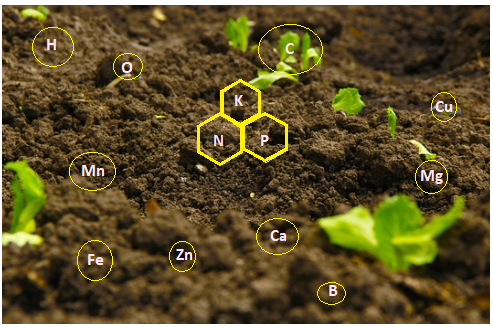
Soil is an important resource that decides the diversity of life in an area. But what is the soil and how is it formed? The outermost layer of our Earth is called the crust and the minerals found in this layer supply a variety of nutrients to life-forms. But these minerals will not be available to the organisms if the minerals are bound up in huge rocks. Over long periods of time, thousands and millions of years, the rocks at or near the surface of the Earth are broken down by various physical, chemical and some biological processes. The end product of this breaking down is the fine particles of soil. But what are the factors or processes that make soil?
• The Sun: The Sun heats up rocks during the day so that they expand. At night, these rocks cool down and contract. Since all parts of the rock
do not expand and contract at the same rate, this results in the formation of cracks and ultimately the huge rocks break up into smaller pieces.
• Water: Water helps in the formation of soil in two ways. One, water could get into the cracks in the rocks formed due to uneven heating by the Sun. If this water later freezes, it would cause the cracks to widen. Can you think why this should be so? Two, flowing water wears away even hard rock over long periods of time. Fast flowing water often carries big and small particles of rock downstream. These rocks rub against other rocks and the resultant abrasion causes the rocks to wear down into smaller and smaller particles. The water then takes these particles along with it and deposits it further down its path. Soil is thus found in places far away from its parent-rock.
• Wind: In a process similar to the way in which water rubs against rocks and wears them down, strong winds also erode rocks down. The wind also carries sand from one place to the other like water does.
• Living organisms also influence the formation of soil. The lichen that we read about earlier, also grows on the surface of rocks. While growing, they release certain substances that cause the rock surface to powder down and form a thin layer of soil. Other small plants like moss, are able to grow on this surface now and they cause the rock to break up further. The roots of big trees sometimes go into cracks in the rocks and as the roots grow bigger, the crack is forced bigger.
As you have seen, soil is a mixture. It contains small particles of rock (of different sizes). It also contains bits of decayed living organisms which is called humus. In addition, soil also contains various forms of microscopic life. The type of soil is decided by the average size of particles found in it and the quality of the soil is decided by the amount of humus and the microscopic organisms found in it. Humus is a major factor in deciding the soil structure because it causes the soil to become more porous and allows water and air to penetrate deep underground. The mineral nutrients that are found in a particular soil depends on the rocks it was formed from. The nutrient content of a soil, the amount of humus present in it and the depth of the soil are some of the factors that decide which plants will thrive on that soil. Thus, the topmost layer of the soil that contains humus and living organisms in addition to the soil particles is called the topsoil. The quality of the topsoil is an important factor that decides biodiversity in that area. Modern farming practices involve the use of large amounts of fertilizers and pesticides.
Use of these substances over long periods of time can destroy the soil structure by killing the soil micro-organisms that recycle nutrients in the soil. It also kills the Earthworms which are instrumental in making the rich humus. Fertile soil can quickly be turned barren if sustainable practices are not followed. Removal of useful components from the soil and addition of other substances, which adversely affect the fertility of the soil and kill the diversity of organisms that live in it, is called soil pollution.
The soil that we see today in one place has been created over a very long period of time. However, some of the factors that created the soil in the first place and brought the soil to that place may be responsible for the removal of the soil too. The fine particles of soil may be carried away by flowing water or wind. If all the soil gets washed away and the rocks underneath are exposed, we have lost a valuable resource because very little
will grow on the rock.
The roots of plants have an important role in preventing soil erosion. The large-scale deforestation that is happening all over the world not only destroys biodiversity, it also leads to soil erosion. Topsoil that is bare of vegetation, is likely to be removed very quickly. And this is accelerated in hilly or mountainous regions. This process of soil erosion is very difficult to reverse. Vegetative cover on the ground has a role to play in the percolation of water into the deeper layers too.
